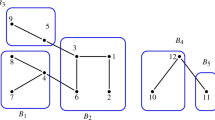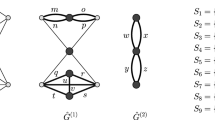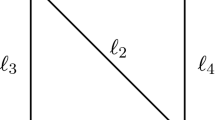Abstract
In this article we study cooperative multi-choice games with limited cooperation possibilities, represented by an undirected forest on the player set. Players in the game can cooperate if they are connected in the forest. We introduce a new (single-valued) solution concept which is a generalization of the average tree solution defined and characterized by Herings et al. (Games Econ. Behav. 62:77–92, 2008) for TU-games played on a forest. Our solution is characterized by component efficiency, component fairness and independence on the greatest activity level. It belongs to the precore of a restricted multi-choice game whenever the underlying multi-choice game is superadditive and isotone. We also link our solution with the hierarchical outcomes (Demange in J. Polit. Econ. 112:754–778, 2004) of some particular TU-games played on trees. Finally, we propose two possible economic applications of our average tree solution.





Similar content being viewed by others
References
Albizuri, M. J. (2009). The multichoice coalition value. Annals of Operations Research, 172, 363–474.
Albizuri, M. J., Aurrekoetxea, J., & Zarzuelo, J. M. (2006). Configuration values: extensions of the coalitional Owen value. Games and Economic Behavior, 57, 1–17.
Aumann, R. J., & Drèze, J. H. (1974). Cooperative games with coalition structures. International Journal of Game Theory, 3, 217–237.
Béal, S., Rémila, E., & Solal, P. (2010). Rooted-tree solutions for tree games. European Journal of Operational Research, 203, 404–408.
Calvo, E., & Santos, C. J. (2000). A value for multichoice games. Mathematical Social Sciences, 40, 341–354.
Demange, G. (2004). On group stability in hierarchies and networks. Journal of Political Economy, 112, 754–778.
Derks, J., & Peters, H. (1993). A Shapley value for games with restricted coalitions. International Journal of Game Theory, 21, 351–360.
Freixas, J. (2005). Banzhaf measures for games with several levels of approval in the input and output. Annals of Operations Research, 137, 45–66.
Gilles, R., Owen, G., & van den Brink, R. (1992). Games with permission structures: the conjunctive approach. International Journal of Game Theory, 20, 277–293.
Grabisch, M., & Lange, F. (2007). Games on lattices, multichoice games and the Shapley value: a new approach. Mathematical Methods of Operations Research, 65, 153–167.
Grabisch, M., & Xie, L. (2007). A new approach to the core and Weber set of multichoice games. Mathematical Methods of Operations Research, 66, 491–512.
Herings, P., van der Laan, G., & Talman, D. (2008). The average tree solution for cycle-free graph games. Games and Economic Behavior, 62, 77–92.
Hotelling, H. (1929). Stability in competition. Economic Journal, 39, 40–57.
Hsiao, C.-R., & Raghavan, T. E. S. (1993). Shapley value for multi-choice cooperative games. Games and Economic Behavior, 5, 240–256.
Hwang, Y.-A., & Liao, Y.-H. (2008). Potential approach and characterizations of a Shapley value in multi-choice games. Mathematical Social Sciences, 56, 321–335.
Khanna, N. (2000). Measuring environmental quality: an index of pollution. Ecological Economics, 35, 191–202.
Khmelnitskaya, A. (2010). Values for rooted-tree and sink-tree digraph games and sharing a river. Theory Decis., 69, 657–669.
Klijn, F., Slikker, M., & Zarzuelo, J. (1999). Characterizations of a multi-choice value. International Journal of Game Theory, 28, 521–532.
Mishra, D., & Talman, D. (2010). A characterization of the average tree solution for tree games. International Journal of Game Theory, 39, 105–111.
Myerson, R. (1977). Graphs and cooperation in games. Mathematics of Operations Research, 2, 225–229.
Owen, G. (1977). Values of games with a priori unions. In R. Hernn & O. Moschlin (Eds.), Essays in mathematical economics and game theory (pp. 76–88). New York: Springer.
Peters, H., & Zank, H. (2005). The egalitarian solution for multichoice games. Annals of Operations Research, 137, 399–409.
Rashid, A., Khanna, A., Gowar, J. P., & Bull, J. P. (2001). Revised estimates of mortality from burns in the last 20 years at the Birmingham Burns Centre. Burns, 27, 723–730.
Shapley, L. S. (1953). A value for n-person games. In A. W. Tucker & H. W. Kuhn (Eds.), Contributions to the theory of games II (pp. 307–317). Princeton: Princeton University Press.
Topkis, D. M. (1978). Minimizing a submodular function on a lattice. Operations Research, 26, 305–321.
van den Brink, R. (forthcoming). Efficiency and collusion neutrality in cooperative games and networks. Games Econ. Behav.
van den Nouweland, A., Potters, J., Tijs, S., & Zarzuelo, J. (1995). Cores and related solution concepts for multi-choice games. ZOR-Mathematical Methods of Operations Research, 41, 289–311.
Acknowledgement
For helpful comments received, the authors want to thank three anonymous referees, and the participants at the MINT 2 workshop in Saint-Etienne. Financial support by the National Agency for Research (ANR)—research program “Models of Influence and Network Theory” (MINT) ANR.09.BLANC-0321.03—and the “Mathématiques de la décision pour l’ingénierie physique et sociale” (MODMAD) project is gratefully acknowledged.
Author information
Authors and Affiliations
Corresponding author
Rights and permissions
About this article
Cite this article
Béal, S., Lardon, A., Rémila, E. et al. The average tree solution for multi-choice forest games. Ann Oper Res 196, 27–51 (2012). https://doi.org/10.1007/s10479-012-1150-1
Published:
Issue Date:
DOI: https://doi.org/10.1007/s10479-012-1150-1




